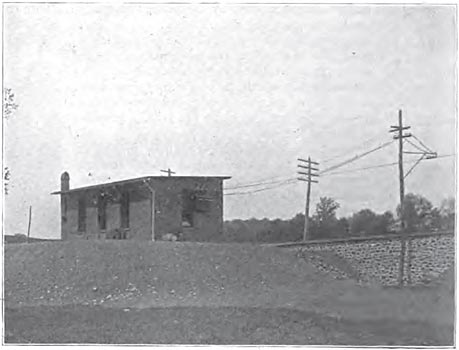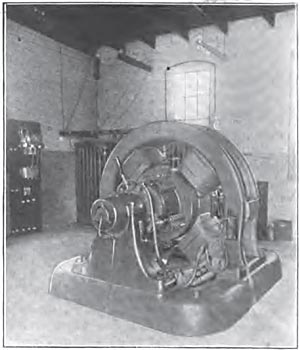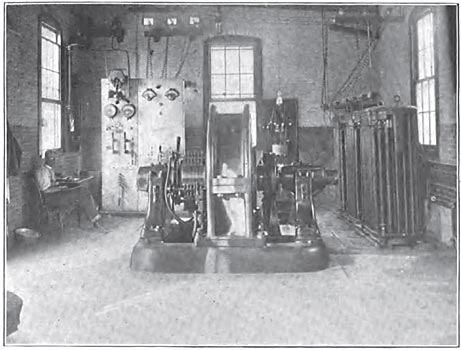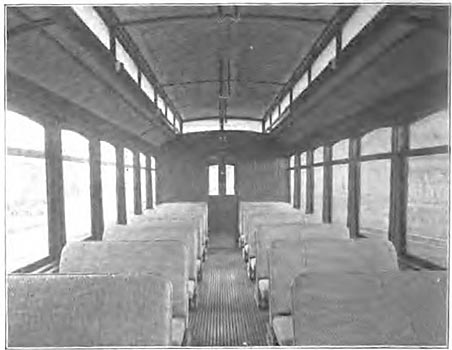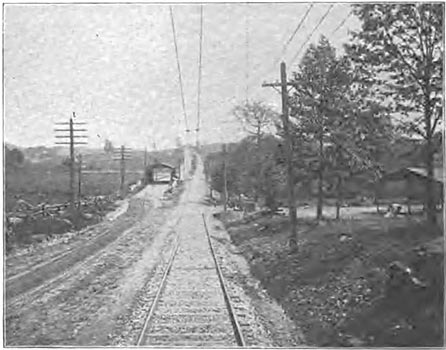[Trade Journal]
Publication: Street Railway Journal
New York, NY, United States
vol. 15, no. 6, p. 353-357, col. 1-2
Three Phase Transmission for Railway Service Near Philadelphia
The increase in the number and extent of suburban electric railways near Philadelphia has kept pace with that surrounding other large cities in this country, and Philadelphia is now connected electrically with Wilmington on the south and Westchester on the west, while the extension of roads to the north is being carried on rapidly. These roads make connections in the outskirts of the city with the system of the Union Traction Company of Philadelphia, but the suburban cars do not run into the center of the city, as in some instances, over the tracks of the city company.
 |
| Interior of Main Power Station—Westchester Traction Company |
Among the lines in operation that of the Philadelphia & Westchester Traction Company is, from an electrical standpoint, probably the most interesting, on account of the use of the three-phase current for power distribution. The line is 20 miles in length, and extends from the corner of Sixty-third and Market Streets, Philadelphia, in almost a direct line along the turnpike, which is controlled by the company, to the Borough of Westchester, which has a population of 15,000. The region traversed is a rich and rolling farming territory, and crosses a series of six ridges and valleys, with grades of from 4 to 6 per cent on each side, some of the grades being over 3500 ft. long. Eight miles of this line, or that from the eastern terminus to Newton Square, were built in 1894, but the old track has been completely reconstructed.
The track is rock ballasted for the entire length, and east of Newton Square is a 58-lb. T rail, furnished by William Wharton. Jr., & Co., with tongue switches, mates and frogs of manganese steel. The ties are 5 ins. x 7 ins. x 7 ft., laid 2-ft. centers. No. 0 trolley wire, with the General Electric overhead material is used. West of Newtown Square 58-lb. Johnson T rails in 60-ft. lengths are used, laid on oak and chestnut ties of the size already mentioned. The trolley wire on this section is a No. 0000, and double for the entire distance, as no feeders are employed. The overhead material is of the General Electric and McCallum type. Within the Borough of Westchester a 9-in. Johnson girder rail in 6-ft. lengths is used, on 6-in. x 8-in. x 8-ft. oak ties. Mayer & Englund 0000 protected bonds are used throughout. The Ramsey block-signal system is used.
The main power station is at Llanarch, 2 ¼ miles from the eastern terminal. It is of red brick on rubble stone foundations, and measures 100 ft. x 52 ft. 5 ins. The roof trusses are of steel, supported by steel columns, wrhich also carry the crane girders. The boiler room is 44 ft. x 51 ft., and 20 ft. high, and contains three Pierpont watertube boilers of 200 h.p. each. These boilers are fed by two No: 10 Sellers injectors, and burn bituminous coal.
The engine room is 52 ft. 5 ins. x 51 ft., and contains two Harrisburg Ideal compound condensing engines, 17 ins. and 28 ins. x 42-in. stroke, each directly connected to a G. E. 400-kw. generator, with a speed of 100 r.p.m. In the basement each engine is connected with a single cylinder air pump and jet condenser, 12 ins. and 16 ins. x 18 ins., manufactured by the Snow Steam Pump Company, which also supplied the steam pump, which is 10 ins. x 5 ins. x 10 ins. In the engine room is also a 15-ton Sellers crane, operated from the main floor. The switchboard is of the standard type of the General Electric Company, with two generator and four feeder panels.
In addition to this machinery, which supplies current to the line from the eastern terminus to Newtown Square, there is also a 250-kw. General Electric rotary converter, taking current from the main bus bar. This converter is of the T C-4-250-750 type, supplying 380 volts on the alternating side and 550 volts on the direct current side, and is run inverted; that is, the direct current side is used as a motor, while current is taken from the alternating side at 25 cycles per second. In the station are also three 90-kw. step-up transformers of 380 volts primary and 6600 volts secondary current connected with the alternating current side of the inverted rotary.
| |||
| Exterior of Rotary Converter Substation |
|
| |||
| Interior of Rotary Converter Substation at Ridley Creek |
The substation is located at Ridley Creek, is of brick, and measures 19 ft. 6 ins. x 32 ft. It is 10 3/4 miles from the power station, with which it is connected by three No. 4 wires carried on porcelain insulators. These were supplied by Mayer & Englund, manufactured by Fred M. Locke, and are carried on white pine cross-arms, on pins spaced 12 ins. apart. After passing the lightning arresters, which are of the G. E. A type, the current passes through aluminum fuses, thence to the oil switches on the switchboard, and thence to three oil-insulated 90-kw transformers, by which it is reduced to 380 volts. At this voltage it is taken to the alternating side of the rotary, while from the direct current side a current of 550 volts is applied to the trolley wire.
Each rotary converter is supplied with a centrifugal governor operated from the extended shaft of the machines. This governor is set so as to throw the circuit breaker on the switchboard, in case the limiting speed, which is about 30 per cent above normal, is reached. The governor consists of two weights, which are thrown out as the speed increases, and when in operation make contact on two rings, which are connected to an auxiliary trip coil on the circuit breaker. On the other side of the machine is placed an end-play device which is in connection with a make and break circuit, which energizes coils and causes a magnetic pull on the armature, thus giving it a to and fro motion in the bearings. The motor for accomplishing this is of the induction class, 4-1/16-750-80 type.
 |
| Section of Track Construction in Westchester |
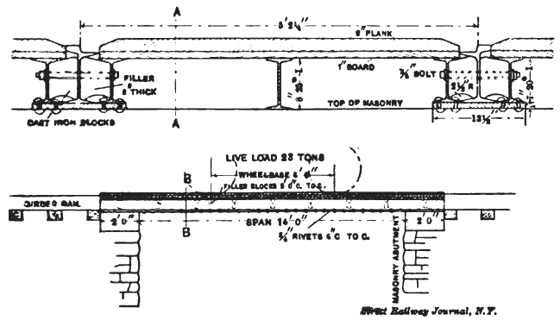 |
| 14-Ft. Span Bridge Over Pennsylvania R. R. |
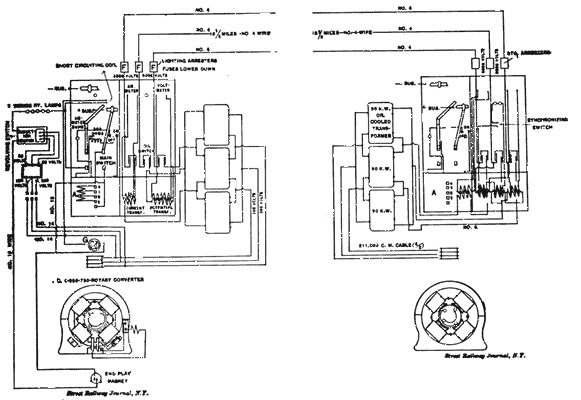 |
| Diagram of Three-Phase Connections at Main and Sub-Station |
In starting the alternating current system, the rotary converter in the main station at Llanarch is first run as an ordinary direct current motor, after which that in the substation is started as an alternating synchronous motor from the alternating side. The amount of current necessary to start this machine is about its full load. The voltage on the direct current side of the rotary converter in the substation is practically the same as that in the main station. This voltage rises, along with the compounding of the large 400-kw. generators, in the main station as the load goes on.
For its rolling stock the company has fifteen ten-bench open cars, made by the Lamokin Car Works, mounted on Brill 21 E trucks, and equipped with Westinghouse No. 38 motors; six small box-cars, built by Brill, and six long closed cars, with smoking compartment, built by Jackson & Sharp. These latter, the latest addition to the company's rolling stock, are 29 ft. 6 ins. in frame, 39 ft. over all and 40 ft. over bumpers. They measure 7 ft. 6 ins. wide over sills, and 8 ft. 2 ins. wide over belt rail, allowing 34-in. seats on each side of the aisle, giving a very wide aisle space.
The interior finish of the cars is quartered oak, with white birch veneer ceilings, handsomely decorated. Between the second and third windows is placed a bulkhead, or partition, dividing the car into two compartments. The main compartment, or passenger room, is fitted with Hale & Kilburn's walkover seats, upholstered in rattan. In the smoking-room end of the car side seats of slats of th« usual type are placed, giving a seating capacity of four on each side, or eight in all, making the total seating capacity of the car forty passengers. The sashes are double and fitted with polished plate glass; the upper light is permanent. The lower sash is made to drop into the side of the car below the belt rail. The lights in the deck are bevel-edge with chipped center, and the glass in the end doors are also bevel-edge, of plate. The end doors of the cars are double, mounted on contra-twist door hangers. The curtains are fitted with Burrowes Climax fixtures. The cars are fitted with especially long platforms, being 5 ft. 3 ins. over all, detachable canopies and vestibule fronts. The outside is painted Tuscan red, and striped and numbered in gold leaf, and lettered in aluminum leaf, which give very handsome effect. The cars are mounted on Peckham 14 A trucks, and are equipped with Westinghouse No. 49 motors and Christensen air brakes. The cars are equipped with New Haven registers and Johns heaters.
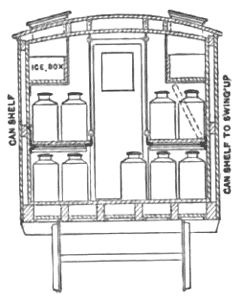 |
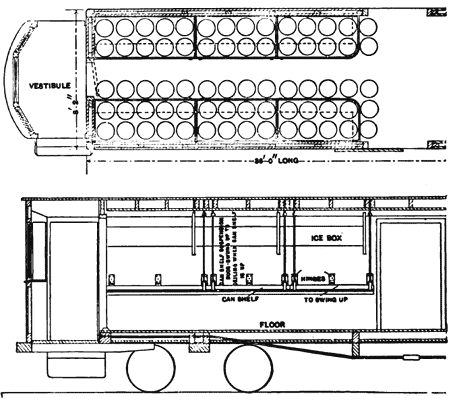 |
| Section and Plan of Milk Car |
A large proportion of the company's business is the carrying of freight and merchandise, of which the transportation of milk forms a considerable item. To accommodate this service the company has recently put on a new milk car of the form illustrated on the preceding page.
|
| |||
| Interior Views of Double Truck Car |
| |||
| View Along the Line |
The line is especially built for high speed, and it is the intention of the company to run the 20 miles in one hour and fifteen minutes. There is no direct steam railroad connection between the terminals of the electric road, and it is thought that considerable through business can be secured, as well as a considerable excursion business in the summer. To encourage the regular passenger business, especially on rainy and cold days, the company will build waiting stations at regular points along the line, and they will be lighted and heated by electricity.
The officers of the Philadelphia & West Chester Traction Company are: President, A. Merritt Taylor; secretary, C. Russell Hinchman; treasurer, Nathan Sellers; electrical engineer, Joseph W. Silliman; superintendent, J. H. Gibson.
The general contractors were Pepper & Register.

